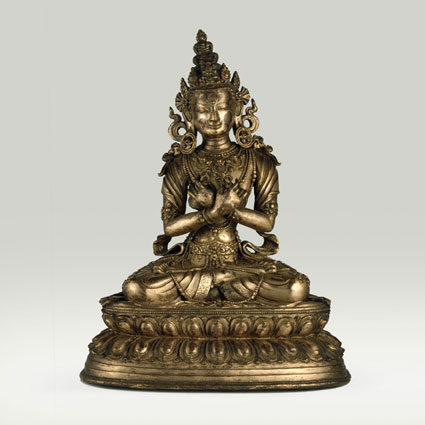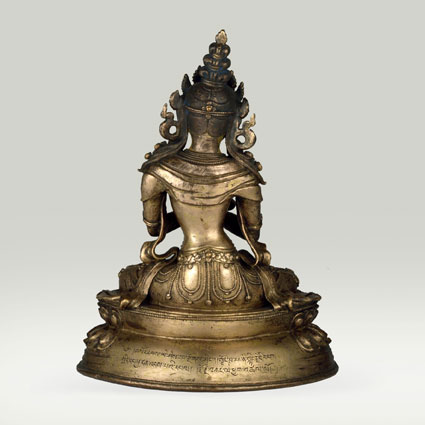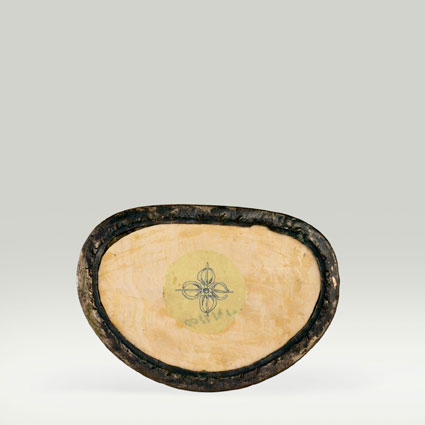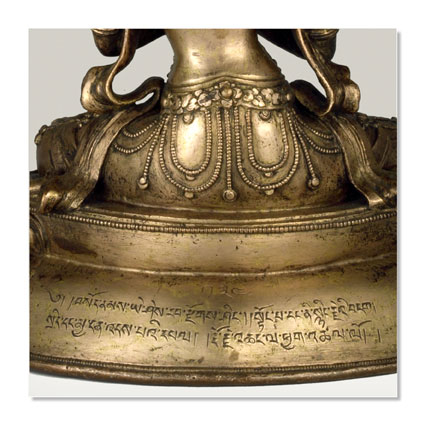Primordial Buddha Vajradhara
ABS 031
Code: ABS 031
Country: Tibet (central)
Style:
Date: 1650 - 1700
Dimensions in cm WxHxD: 14.2 x 23.8 x 7.3
Materials: Gilt copper
Hollow cast in one piece.
The jewelled ornaments are worked without inset semi-precious stones.
The bottom of the pedestal is not sealed.
Vajradhara (Tib. rDo rje ’chang), slightly bent at the hip and neck, is seated in the diamond attitude (vajraparyankasana) on a double lotus pedestal with an upper beaded borders. The right hand holding a five-pronged diamond sceptre (vajra) and the left hand holding a prayer-bell (ghanta) are, with the hands turned inwards, crossed over of the chest (prajnalingabhinaya). An image of Vajrasattva, when depicted with this gesture, is generally identified as Vajradhara. He is clad with a cloth tied around his waist with a belt with attached beaded strings. Vajradhara wears princely ornaments, namely a five fold crown, a pair of earrings, necklaces with attached pendants, and ornaments at the upper arms and wrists, and anklets.
On the back of the pedestal is a dedicatory Tibetan inscription in dBu canscript: // bsod nams ye shes rab rdzogs shing / stong pa dang ni snying rje bdag srid dang mya ngan ’das pa’i dpal rdo rje ’chang la phyag ’tshal lo //. "........... ........... ............ ........... ............ ............ ............ .............................". [See French translation by Amy Heller].
The “old translation tradition” (snga bsgyur) Tantras of the rNying ma tradition identify the Adibuddha (Tib. Dang po’i sangs rgyas) with Samantabhadra (Tib. Kun tu bzang po), the “new translation traditions” (gsar ma pa), namely the bKa’ brgyud, Sa skyaand dGe lugs traditions, identify him with Vajradhara (Tib. rDo rje ’chang).
The jewelled ornaments are worked without inset semi-precious stones.
The bottom of the pedestal is not sealed.
Vajradhara (Tib. rDo rje ’chang), slightly bent at the hip and neck, is seated in the diamond attitude (vajraparyankasana) on a double lotus pedestal with an upper beaded borders. The right hand holding a five-pronged diamond sceptre (vajra) and the left hand holding a prayer-bell (ghanta) are, with the hands turned inwards, crossed over of the chest (prajnalingabhinaya). An image of Vajrasattva, when depicted with this gesture, is generally identified as Vajradhara. He is clad with a cloth tied around his waist with a belt with attached beaded strings. Vajradhara wears princely ornaments, namely a five fold crown, a pair of earrings, necklaces with attached pendants, and ornaments at the upper arms and wrists, and anklets.
On the back of the pedestal is a dedicatory Tibetan inscription in dBu canscript: // bsod nams ye shes rab rdzogs shing / stong pa dang ni snying rje bdag srid dang mya ngan ’das pa’i dpal rdo rje ’chang la phyag ’tshal lo //. "........... ........... ............ ........... ............ ............ ............ .............................". [See French translation by Amy Heller].
The “old translation tradition” (snga bsgyur) Tantras of the rNying ma tradition identify the Adibuddha (Tib. Dang po’i sangs rgyas) with Samantabhadra (Tib. Kun tu bzang po), the “new translation traditions” (gsar ma pa), namely the bKa’ brgyud, Sa skyaand dGe lugs traditions, identify him with Vajradhara (Tib. rDo rje ’chang).
Vajradhara
Vajradhara is the ultimate Primordial Buddha, or Adi Buddha, according to the cosmology of Tibetan Buddhism. Vajradhara displaced Samantabhadra Buddha in Gelug and Kagyu mythologies, but is metaphysically equivalent. Achieving the 'state of vajradhara' is synonymous with complete realisation.
From the primordial Vajradhara/Samantabhadra were manifested the Five Wisdom Buddhas (Dhyani Buddhas):
* Akshobhya
* Amoghasiddhi
* Amitabha
* Ratnasambhava
* Vairocana
Vajradhara and the Widsom Buddhas are often subjects of mandala.
Vajradhara and Samantabhadra are cognate deities with different names, attributes, appearances and iconography. Both are Dharmakaya Buddhas, that is primordial Buddhas, where Samantabhadra is unadorned, that is depicted without any attributes. Conversely, Vajradhara is often adorned and bears attributes, which is generally the iconographic representation of a Sambhogakaya Buddha. Both Vajradhara and Samantabhadra are generally depicted in yab-yum unity and are primordial buddhas, embodying void and ultimate emptiness.
Vajradhara is the ultimate Primordial Buddha, or Adi Buddha, according to the cosmology of Tibetan Buddhism. Vajradhara displaced Samantabhadra Buddha in Gelug and Kagyu mythologies, but is metaphysically equivalent. Achieving the 'state of vajradhara' is synonymous with complete realisation.
From the primordial Vajradhara/Samantabhadra were manifested the Five Wisdom Buddhas (Dhyani Buddhas):
* Akshobhya
* Amoghasiddhi
* Amitabha
* Ratnasambhava
* Vairocana
Vajradhara and the Widsom Buddhas are often subjects of mandala.
Vajradhara and Samantabhadra are cognate deities with different names, attributes, appearances and iconography. Both are Dharmakaya Buddhas, that is primordial Buddhas, where Samantabhadra is unadorned, that is depicted without any attributes. Conversely, Vajradhara is often adorned and bears attributes, which is generally the iconographic representation of a Sambhogakaya Buddha. Both Vajradhara and Samantabhadra are generally depicted in yab-yum unity and are primordial buddhas, embodying void and ultimate emptiness.
Sèngué, Tcheuky, 2002. Petite Encyclopédie des Divinités et symboles du Bouddhisme Tibétain. Editions Claire Lumiere . Pp. 106-107 - Références françaises: Vajradhara






